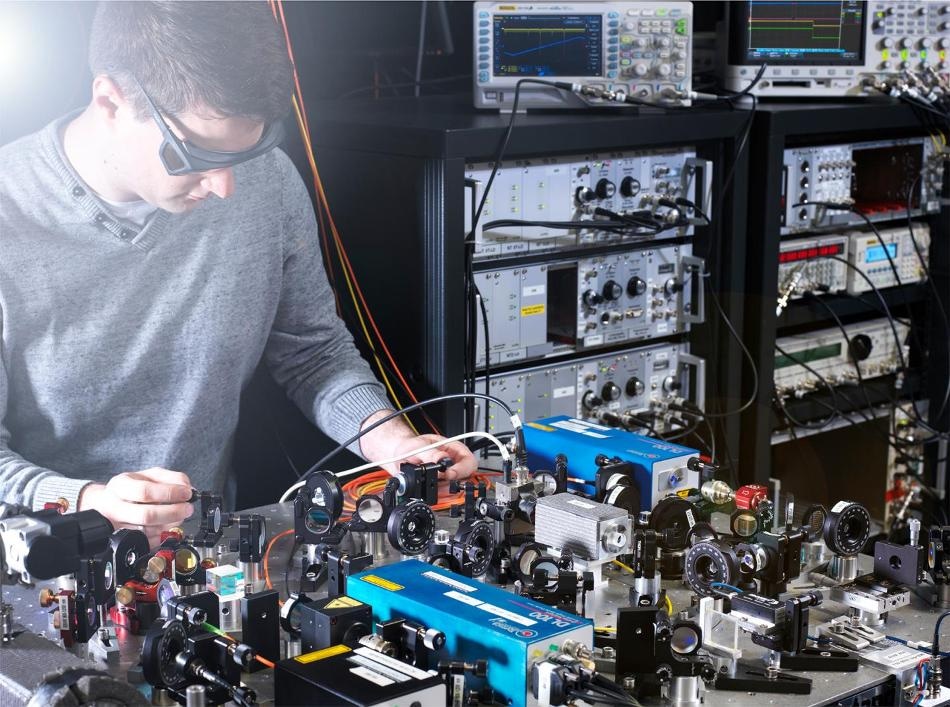Apr 20 2018
A property distinctive among all familiar nuclides is observed in the nucleus of thorium-229: It must be feasible to excite it using ultraviolet light. So far, there has been limited knowledge on the low-energy state of the Th-229 nucleus that is accountable for this attribute.
 PTB scientist Johannes Thielking with the laser setup for measurements of the thorium-229 nuclear properties. (Image credit: PTB)
PTB scientist Johannes Thielking with the laser setup for measurements of the thorium-229 nuclear properties. (Image credit: PTB)
Scientists from the Physikalisch-Technische Bundesanstalt (PTB) collaborated with colleagues from Munich and Mainz to perform the first-ever measurements—with the help of optical techniques—of some significant properties of this nuclear state, for example, the shape of its charge distribution. In this manner, it is possible to monitor a laser excitation of the atomic nucleus, thereby enabling an optical nuclear clock to be developed that “ticks” more accurately when compared to prevalent atomic clocks. The outcomes of the study have been described in the latest issue of the journal Nature.
Nearly one and a half decades earlier, Ekkehard Peik and Christian Tamm started to develop the idea of an innovative atomic clock that had distinctive characteristics, at PTB in Braunschweig: As opposed to using a transition frequency between two states in the electron shell as the pulse generator of the clock, which is the case for all the prevalent atomic clocks, they conceptualized the usage of a transition frequency in the nucleus. Since the neutrons and protons in the nucleus are densely packed than the electrons in the atomic shell by a number of orders of magnitude, their response to outside disturbances that can alter their transition frequencies is less sensitive - thereby offering better conditions for a high-precision clock.
Yet, the frequencies of nuclear transitions are also considerably higher when compared to those of shell transitions (in the X-ray range); hence, they cannot be used for atomic clocks, which, thus far, have been solely based on laser light or microwaves. The only known exception and the basis for PTB’s proposal is the nucleus of Th-229. This nucleus has a quasi-stable, isomeric nuclear state at extremely low excitation energy. Due to this, there exists a transition between this isomer and the ground state, which lies within the frequency range of ultraviolet light and hence within the reach of laser technology similar to the one used in prevalent optical atomic clocks.
At present, over 10 research teams across the globe are working on studies related to the possibility of developing a Th-229 nuclear clock. Under experimental conditions, it has been very challenging to prove this issue. As a result, there has been no success in monitoring the nuclear transition with the help of optical techniques since an in-depth understanding of the exact excitation energy of the isomer has been only approximate.
As desired for the clock, the resonance of the transition is extremely sharp and can only be observed if the frequency of the laser light precisely matches the energy difference of both states. The problem, therefore, resembles the proverbial search for a needle in a haystack.
Dr. Ekkehard Peik.
In 2016, Dr. Peik’s collaborators from Ludwig-Maximilians-Universität (LMU) in Munich described their first advancement in the journal Nature: As a first-ever attempt, they could demonstrate the nuclear transition within the Th-229 nucleus, although the techniques adopted by them were very different from those used for an atomic clock.
Apart from researchers at PTB and LMU, this collaborative study involved researchers from Johannes Gutenberg University Mainz, the Helmholtz Institute Mainz and GSI Helmholtzzentrum für Schwerionenforschung Darmstadt. The study has at present taken another conclusive turn: as a first-ever achievement, the fundamental characteristics such as the shape and size of the charge distribution could be evaluated in the excited state of the Th-229 nucleus. In order to achieve this, instead of exciting the Th-229 nuclei from their ground state (which will be the case in the clock in the future), they were obtained in the excited state, in a device developed by LMU, as a result of the alpha decay of uranium-233, slowed down, and stored as Th2+ ions in an ion trap.
A uranium-233 source appropriate to achieve this was offered by the groups in Mainz and Darmstadt. With the help of laser systems designed at PTB for the spectroscopy of these ions, the transition frequencies in the electron shell could be measured accurately. Since the nuclear properties have a direct impact on these frequencies, they can be adopted to acquire information on these properties. So far, entirely theory-based models have not been successful in predicting the behavior of the structure of the Th-229 nucleus at the time of this unusually low-energy transition. Moreover, since the structure of the electron shell can be easily measured with the help of spectroscopy, it can also be used to demonstrate a laser excitation of the nucleus.
Although it does not indicate that the quest for the optical resonant frequency of the Th-229 nucleus, or the “needle in the haystack,” is complete, there is a clear understanding of the actual needle. This has brought the researchers a significant step nearer to the optical atomic clock.